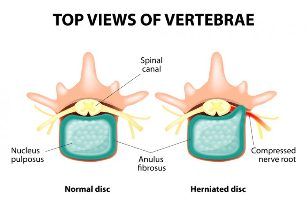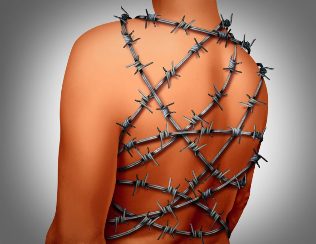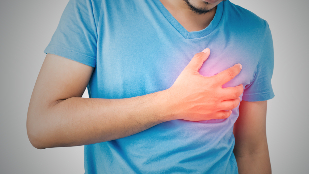Thoracic spine

The thoracic spine is represented by 12 vertebrae, between the bodies of which there are intervertebral discs. The discs consist of a pulposus nucleus and an annulus fibrosus. Pathological changes in these discs, as well as in adjacent facial joints, growth of bone spines along the edges of the vertebral bodies, dystrophic processes in the back ligaments and become the direct cause of back pain.
It should be understood that osteochondrosis, as a disease, rarely affects only a part of the spine. Usually this process is diffuse, more or less pronounced in different parts of the spine.
Some structural features of the thoracic spine make it less affected by osteochondrosis than other regions of the spine. Let’s list these features:
- less mobility of the thoracic spine;
- the presence of rib bead joints (which, in combination with the sternum, creates a strong chest frame, less prone to injury);
- small thickness of intervertebral discs;
- physiological kyphosis (anteroposterior curvature with a posteriorly directed bulge) of the thoracic spine, and therefore the maximum axial load falls on the anterior rather than posterior discs.
And yet, in the presence of provocative factors, such as a sedentary lifestyle (including years of working at a desk or driving a car), injuries, poor posture, muscle wasting, hard physical work ina forced position, osteochondrosis of the thoracic spine indicates his true face.
Symptoms of osteochondrosis of the thoracic spine
The main clinical symptom of osteochondrosis of the thoracic spine, as well as other parts, is pain. Back pain, chest pain, and even pain in the internal organs. In medicine, it is customary to distinguish several pain syndromes (and not just pain) of osteochondrosis of the thoracic spine. In total, they are divided into two groups:
- reflex;
- compression.
Reflex syndromes are clinical manifestations of spinal receptor stimulation. These are receptors for ligaments, capsules of intervertebral joints, intervertebral discs, which receive pathological impulses in osteochondrosis. In addition to pain, reflex syndromes can be accompanied by muscle tension, vegetative disorders in soft tissues, and internal organs. Such changes are based on the following fact: stimulation of receptors leads to the spread of excitation in adjacent spinal cord structures (to be more precise, in spinal cord segments). And these can be neurons responsible for sweating a certain area of the skin, regulating the temperature of the same area, participating in ensuring the activity of internal organs (heart, liver, intestines, etc. ), maintaining the tone ofthe muscles and blood vessels that supply all of these structures. And when the stimulus is transmitted to these neurons, the corresponding symptoms of disruption of the activity of certain formations arise. Therefore, such a situation is quite possible when pain in the abdomen or in the region of the heart is caused by osteochondrosis of the thoracic spine.
Compression syndromes occur when the nerve root is compressed (stretches less frequently) when it leaves the intervertebral foramen, spinal cord tissue, or the vessels that feed it. Compression syndromes are almost always caused by an existing disc herniation. The most common are hernias of the lower chest segments. Depending on the direction and location of the hernia, a person experiences certain symptoms. This can be represented as follows:
- Moderate (moderate) hernias are accompanied by the development of muscle weakness symmetrically in both legs, loss of sensitivity in them. At the same time, the typical pain syndrome for nerve root compression is absent;
- lateral (lateral) hernias exhibit pain exclusively associated with nerve root compression;
- medial-lateral hernias combine the clinical symptoms of the previous two groups, only muscle weakness and sensory disturbances predominate on the side of the protruding disc.
What types of syndromes are considered within the thoracic spine osteochondrosis framework? Let’s talk in more detail about the types of reflex and compression syndromes of this level.
Reflex Syndromes
Dorsago- sudden sharp pain in the thoracic spine. It is of a sharp nature, often described by patients as a stab with a dagger. Basically, it is felt between the shoulder blades, can be given to the heart, the sternum. Patients are afraid to move and even breathe deeply because the pain intensifies (as if stretching again) from this. Very often, these symptoms occur after a long stay in a fixed uncomfortable behavior, while performing monotonous work. A sudden movement after this provokes dorsago in people with osteochondrosis of the thoracic spine. Palpation of the thoracic spine reveals the tension of the paravertebral muscles in the form of a roller and their soreness.
Sometimes such pain can be considered a heart attack, so severe and sudden it seems to the patient. However, the electrocardiogram obtained has no abnormalities and the use of nitroglycerin under the tongue does not eliminate the pain.
Dorsalgiais another type of reflex thoracic syndrome. It is a pain syndrome that occurs gradually. The pain can be localized to any part of the back, chest. Painful, dull pain, sometimes with a burning tinge (which is accompanied by irritation of the vegetative structures). It is intensified by the movements of the spine, bending, rotating around its axis, coughing or sneezing, driving on an uneven road.
Pain can be felt along the intercostal spaces on one or both sides. This characteristic is due to the flow of nerve conductors (nerves and intercostal vessels are located in the intercostal space). In this case, the pain is called intercostal neuralgia, by analogy with herpes pain.
If the pain is localized in the anterior chest wall, it is otherwise called pectalgia. However, it can only be felt in some places with an intact back. For example, in the area of the xiphoid process or at the junction of the sternocleidomastoid muscle. Too often, due to the painful and dull nature of the pain, it is difficult to understand exactly where it hurts: either something inside the chest, or in the area of superficial soft tissue.
Dorsalgias may be associated with reflex tension of the paravertebral muscles, more pronounced on the pain side. In this case, of course, the muscle tension is not as pronounced as in a similar situation in the lumbar spine. But still, when touching, muscle compression is felt and touching itself causes discomfort or pain. Painful is also palpation of the intervertebral spaces and paravertebral points in the area of the segment affected by osteochondrosis.Reflex syndromes in thoracic spine osteochondrosis are much more common than compression.
Compression syndromes
Nerve root compressionis accompanied, first and foremost, by pain syndrome. The pain is shooting in nature. The direction of pain propagation corresponds to the flow of nerve fibers. In the case of thoracic osteochondrosis, these are intercostal spaces. Since some of the nerve fibers form the plexus involved in innervating the internal organs, pain can be felt inside the chest, abdomen. The pain intensifies during movement, body bending, coughing, sneezing, laughing (because in these moments the root tension increases). In the area irritated by the compressed root, sensitivity disorders can be observed: a feeling of crawling, numbness, tingling sensation. Touching this area may not feel good. In cases where the nerve root is subjected to compression for a long time, movement disorders can occur, i. e. muscle weakness that irritates. The muscles gradually atrophy. However, movement disorders are very rare because they are the latest in the chronology of onset of all symptoms. Usually, a person seeks medical help in the stage of pain and sensory disorders.
Spinal cord compressionmanifests as weakness in the leg with a simultaneous increase in muscle tone (if the spinal cord is compressed in the lower back, muscle tone decreases). Pathological symptoms of the foot may appear (Babinsky et al. ). Sensitivity in the lower extremities is lost, the sensation of touching cold and heat does not change, the difference between just touching and injection. In cases of severe spinal cord compression, urinary disorders may occur.
Compression of blood vessels,supply to the spinal cord, leads to the development of myeloidemia, ie malnutrition of spinal cord tissue. This, as well as spinal cord compression, is associated with the development of muscle weakness (patients say "legs have failed"), loss of sensation, and pelvic disorders.
It is fair to say that compression of the spinal cord and its vessels in thoracic spine osteochondrosis is very, very rare.
Vegetative components of thoracic spine osteochondrosis

Due to the fact that the nerve fibers coming from the thoracic spine contain autonomic conductors, irritation or damage to these fibers may be associated with autonomic symptoms. These could be:
- dryness and peeling of the skin in the innervation area of a particular nerve;
- local violation of sweating and thermoregulation (also according to the innervation area);
- coldness of the lower extremities, brittle toenails;
- pain simulates diseases of the gastrointestinal tract (for example, gastritis, gastric ulcer, cholecystitis, etc. );
- kidney pain, which in fact has nothing to do with kidney pathology (no changes in urine and ultrasound);
- pain in the heart region, very similar to angina pectoris and even myocardial infarction.
The peculiarity of such pain may be the fact that a person may not feel back pain. This is initially misleading for both the patient and the medical staff when seeking medical help. However, performing a number of additional research methods makes it possible to rule out pathology of the internal organs, and then osteochondrosis of the thoracic spine is considered the cause of such pain.
Treatment of osteochondrosis of the thoracic spine
All treatment methods for osteochondrosis of the thoracic spine are divided into medicated and non-medicated. In most cases, only a combination of both groups gives an effect, and the disease recedes. Although you should understand that it is simply impossible to completely get rid of osteochondrosis of the thoracic spine. The degenerative process can be suspended, slowed down, but there is no reverse development.
Medications
The main directions of drug exposure for thoracic spine osteochondrosis are pain elimination, elimination of muscle tension, improvement of microcirculation and tissue trophism.
Non-steroidal anti-inflammatory drugs are used successfully to eliminate pain syndrome. Drugs in this group have the ability to reduce the inflammatory process, eliminate pain, and block platelet aggregation. The drug is prescribed, on average, for 7-14 days. This is usually enough to eliminate the pain. Many of them are available in different forms (tablets, capsules, solutions for injection, rectal suppositories), which ensures ease of use. The first few days of treatment, the medication is used in the form of an injection, and then switched to tablets or suppositories. The same drugs can be used simultaneously locally: in the thoracic spine. Moreover, for this purpose, there are also different forms of release: creams, oils, gels, plasters.
Sometimes non-steroidal anti-inflammatory drugs (NSAIDs) are not enough to relieve pain. In such cases, use the use of analgesic mixtures. The mixture is injected intravenously into a saline or glucose solution.Paravertebral blockade has a very good and fast analgesic effect. This is a type of medical manipulation, when a drug is injected near the spine intracutaneously, subcutaneously, into the thickness of muscle tissue, perineurally (directly near a nerve or root). The procedure requires certain skills and experience of the doctor.
Irritating and distracting oils can also be used to reduce pain in osteochondrosis of the thoracic spine. These are oils that contain snake venom, bee venom and spice extracts.Muscle tension is relieved by non-medicated methods.
Diuretics, hormones, Escina Lysins are used to relieve nerve root edema.
Pentoxifylline, Dipyridamole, Complamin, nicotinic acid are used to normalize blood circulation, improve tissue nutrition, and restore trophism.
In thoracic spine osteochondrosis, B vitamins are shown, which have analgesic and neurotrophic effects.
When worsening osteochondrosis of the thoracic spine is arrested, you can use the use of medications that improve disc metabolism between joints and joints. These are the so-called chondroprotectors. These drugs stimulate the regeneration of articular cartilage, suspend the degenerative process in the intervertebral discs. They are prescribed for a long time (3-6 months).
Non-medicated methods
These include:
- massage (classic, point, reflex-segmental);
- physiotherapy exercises;
- stretching of spasmodic muscles (there are special techniques, stretching is not done according to the "as you want" principle);
- acupuncture;
- swimming (very useful for all patients with any localization of osteochondrosis);
- physiotherapy (ultrasound, electrophoresis, amplipulse, diadynamic current, mud therapy, etc. ).
If a hernia formed as a result of osteochondrosis of the thoracic spine compresses the spinal cord, its vessels or nerve roots and at the same time causes muscle weakness, pelvic organ dysfunction, pronounced pain syndrome (resistant to the use ofmedication), then the issue is considered in relation to the performance of surgical treatment.
Osteochondrosis of the thoracic spine is not a deadly disease, but it does a lot of harm to a sick person. Limits his life, interferes with work and good rest. The main symptom of osteochondrosis of the thoracic spine is pain. It is impossible to completely get rid of this disease, but it is possible to suspend the degenerative process and minimize its manifestations.




































